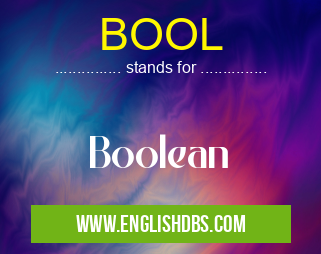What does BOOL mean in SOFTWARE
BOOL is an abbreviation that stands for Boolean. In the context of computing, BOOL refers to a data type that can only represent two possible values: TRUE or FALSE. BOOL data types are commonly used in programming languages to represent logical conditions or to store the results of logical operations.

BOOL meaning in Software in Computing
BOOL mostly used in an acronym Software in Category Computing that means Boolean
Shorthand: BOOL,
Full Form: Boolean
For more information of "Boolean", see the section below.
BOOL in Programming
BOOL data types are often used in programming languages to represent the result of a comparison operation, such as whether one number is greater than another or whether a string is empty. They are also used to represent the state of a variable, such as whether a user has logged in or whether a file has been created.
Logical Operations with BOOL
BOOL data types support logical operations such as AND, OR, and NOT. These operations can be used to combine multiple BOOL values to create more complex logical expressions. For example, the following code checks if both x and y are equal to true:
if (x == true) && (y == true) {
// Both x and y are true
}Essential Questions and Answers on Boolean in "COMPUTING»SOFTWARE"
What is a Boolean variable?
A Boolean variable is a type of variable that can only hold one of two possible values: TRUE or FALSE. Boolean variables are often used to represent logical conditions or to control the flow of execution in a program.
How are Boolean variables used in programming?
Boolean variables can be used in a variety of ways in programming, including:
- To represent the result of a logical expression
- To control the flow of execution in a program
- To store the state of a system or object
What are some examples of Boolean variables?
Some examples of Boolean variables include:
- A variable that represents whether a user has logged in to a system
- A variable that represents whether a file exists on a disk
- A variable that represents whether a condition is true or false
How can I create a Boolean variable in a programming language?
The syntax for creating a Boolean variable varies from programming language to programming language. However, in most languages, you can create a Boolean variable by using a keyword such as "bool" or "boolean". For example, in the Java programming language, you can create a Boolean variable as follows:
boolean isLoggedIn = true;How can I use Boolean variables in a program?
You can use Boolean variables in a program in a variety of ways, including:
- To compare two values
- To control the flow of execution
- To store the state of a system or object
Final Words: BOOL data types are a fundamental part of many programming languages. They provide a convenient way to represent logical conditions and to perform logical operations. By understanding how BOOL data types work, programmers can write more efficient and reliable code.
